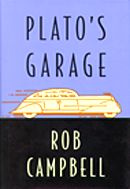|
|
||||||||
| Excerpts: | ||||||||
|

Letter From the Editor
![]()

 "Love Child"
"Love Child"
From Plato's Garage
When I first got to pick out my own car as a high school junior, there was no way it could have been anything other than a 1972 Pininfarina-designed Fiat Spider convertible, either midnight blue or maroon. While I was saving up for it the previous year, I fixated on this year and model because it fit perfectly into the template of automotive perfection that had taken shape in my head. Other than the fact that 1972 was the year before Fiat added two bulbous hood lumps that ruined the Spider's line -- supposedly to accommodate an overhead cam or some such mechanical addition -- I couldn't explain why. It just felt right. I ended up buying one in a deep maroon from a couple who were having to expand their seating options because of a new baby. They were loath to let it go, which made me feel privileged when they decided to sell it to me. Over the next year, that car became my social proxy in a town where it was possible (and often preferable) to do almost anything without leaving your car. When I drove it, I felt confident and whole.
After graduating from high school in 1984, I moved down to Hollywood and unraveled into a thousand threads of vague possibility, each tugging outwards from my enter to disparate zones of my mind and the city. Because the Fiat had lost the power to keep me together, it fell apart too. Within a couple of months, its top got ripped, its glossy wine-colored paint job was keyed twice, its stereo was stolen, and its front tires were slashed. Then the brakes went out and the engine died, so I sold it for parts the way relatives of a fatal-accident victim might distribute their loved one's organs to others in need. This left a voice, both in my mind and my physical existence, that ached to be filled. I was in a big new city trying to define myself in a big new way, and finding the right car, which I deemed absolutely necessary in a city where not owning a car is akin to being homeless, was an important part of this effort.
I couldn't afford a new car right away, so I bought a bright blue Honda moped as an interim mode of transportation and rode it up and down the main drags of the city after classes and on weekends, all the way from the beach to Chinatown or South Central and back again. My focus on people and their cars was so intense that I learned to read the city's inhabitants through the cars they drove and the way they drove them. Sometimes I would test my acumen by following someone from a shopping center or restaurant into the parking lot, guessing beforehand what kind of car they would approach I was right about 80 percent of the time. This got boring after a while due to the enormous predictability factor. Then I saw Angelyne drive past me in her pink Corvette for the first time, and soon after that I found myself switching lanes with Known Actor Dennis Woodruff.
Woodruff is one of the most unsavvy, unloved, and unemployed people in Hollywood, yet he has achieved a small amount of local fame merely because he is so damned visible on the streets of Los Angeles. In the early 1980s, he began tooling around in a huge, unidentifiable convertible festooned with buttons, press clippings, head shots, anonymous decorative paraphernalia, and homemade signs and proclaiming Known Actor Dennis Woodruff Seeks His Big Break. Everybody in town knows who he is, and nobody wants to work with him. Undaunted, Woodruff, looking more the weathered huntsman with every passing year, is still on safari for that big break, tracking it down across the plains, stopping at crowded watering holes, and moving on. He has worn out many rolling resumes along the way: The convertible was followed by a Cadillac limousine, which in turn gave way to a more economical Plymouth Colt, each with its own rotating signage and display components. When he can afford it, he rents a room at the Sunset Boulevard Travelodge, but tends to sleep in his car, shaving and showering at the local Holiday Spa. I was gawking the first time I saw him. He turned his square, clefted chin to me and gave a quick, firm wave before speeding up and changing lanes. Since then, he's been a constant fixture in my daily life. He is regularly reported to have been seen in several distant parts of the city at once.
Angelyne has also become a frequent radar blip on my scanner since my first sighting -- a pink blip, not only because she wears pink and drives a pink car, but because everything about her is pink, from her cotton-candy blond hair tied up in its tuft of Shih-Tzu chic to her pinky-peach skin to her Play-Doh pink toenails peeping out of her pink-tinted plasticene mules. At times, Angelyne -- or at least representations of Angelyne -- cannot be avoided in any part of Los Angeles. During these periods, variations on the theme of her mega-Barbie image are slathered across sides of buildings and hoisted high above every major freeway and surface street on billboards. Some are kittenish and cross-eyed, others are small-toothed and unspecifically deformed, reminding me of the dissipated beauties in Japanese ukiyo-e drawings of the late Meiji period. Sometimes, these images proliferate so wildly that all of Hollywood seems to be filled with her immense, pink-bikinied breasts. At other times, they fade and fall into disrepair, or are covered up by Nike ads and political slogans. These are the times at which the living, breathing Angelyne can be spotted roaming about her habitat, from the top of a hill above the Sunset Strip to the far corners of Hollywood, and sometimes extending into the San Fernando Valley, apparently going to photo shoots to create more images of herself, since this seems to be all she actually does.
Angelyne first burst onto the scene in the early eighties, or rather she created her own scene, which promptly descended over the city like a tight, stretchy atmosphere made out of filmy pink Lycra. True to her numerous and endlessly recycled billboard images, she appears sex-doll plump and ageless until you see her up close, when speculations about plastic surgery and failing skin elasticity become impossible to avoid. Her age is a favorite subject of aficionados. The more rigorous of those whom I have run across swear that she must be sixty, but most are content with the intentionally vague "fortyish." Her public relations material, with its constantly mutating list of curricula that has included everything from lead singer in a punk band to B-movie body double, places her somewhere between thirty and thirty-five. According to interviews in local papers, she is "into" a lot of new-agey stuff like angels and crystals, and claims to have spoken through a medium to Marilyn Monroe, who advised her on her career (whatever that my be.) "Not content to be labeled a singer, actress, dancer or performer of any kind," her fan club bio states, "Angelyne's image and persona capture the glamour and magic of stardom in its purest form." This sounds like hyperbole until you spot her driving by. The pink Corvette is hard to miss. She looks like she has been surgically implanted in the driver's seat, and the supercharged poetry of this perfect symbiosis between car and driver always leaves me breathlessly excited.
As I continued to spot Angelyne and Woodruff driving around in their cars, each time struck by the ceaseless momentum involved in the upkeep of their own iconic ideals of themselves, I realized that they had achieved what I had ploddingly attempted with my Fiat -- a self-expression in which the automobile was an integral and active element. I found myself drawn to them, as if I could learn something by watching the way they interacted with their cars. I began to see at least one of them every day. By all accounts, this is far more often than normal, even for a resident of central Hollywood.
Meanwhile, I continued my search for the next perfect car, now informed by Woodruff's and Angelyne's extreme examples of automotive indentikit wizardry. I quickly ran through a string of would-be classics I intended to restore but never did due to lack of funds, time, and interest: a baby-blue '66 Mustang whose engine blew up on the southbound 405; a red-and-white VW bus that I rammed into the side of an office building when its brakes went out; an olive green '71 Mercury Cougar that wouldn't start again after going through the car wash at Santa Monica and La Brea. (I sold it to another customer for 600 dollars.)
One windy Thursday night in 1992, my friend Fred and I were standing around smoking cigarettes in the alley behind a theater where we were both performing in a play. I think we were wearing tights. We were telling each other increasingly gruesome horror stories about our oh-so-tragic childhoods when Fred confessed that he had always believed he was actually the love child of Elvis Presley and Ann-Margret, conceived during breaks in shooting for the grand finale of Viva Las Vegas. I had always thought (or hoped)( that my parents would tell me one day that I had been adopted, so I started to wonder whose love child I was. As we finished our cigarettes and went back inside to wait for our (infrequent) cues, it dawned on me that, in this alternate universe that Fred and I -- and many others I knew -- inhabited, I was the love child of Angelyne and Known Actor Dennis Woodruff. I pictured them in 1965, wayward wannabe teenage superstars hanging out on the fringes of the swinging Sunset Strip, each attracted to the other's rabid ambition and insurmountable blondness, falling into each other's grabbing arms in the back of one of the roadie buses during the Stones concert at the Greek. Fred thought this sounded perfectly feasible, and it gave me new stock in finding out what their lives were really all about.
Some time later, I saw Woodruff at a coffeehouse on Sunset Boulevard, where he was talking to a guy in a business suit who kept looking down at the beeper that was clipped to the inside of his breast pocket. I stopped and ordered an iced coffee, then slipped in at an adjacent table to eavesdrop on their conversation. What was most apparent was that, in spite of Woodruff's attempt to be responsive and friendly, the suit couldn't wait to get out of there.
I then saw Woodruff on the Maury Povich show -- an episode about people who lived in their cars. Povich was helping them change their lives. As part of the show, Povich arranged a reading for a small part on Baywatch for Woodruff. As I watched his audition, I became drenched with empathic flop sweat. It wasn't that he was such a terrible actor -- he was merely unoffensively bad. But despite his perfectly acceptable mien (considering that he had been living in his car for ten years and had become the epitome of failure to other would-be actors), he couldn't disguise something about himself that was just plain repellent. He didn't get the part, and the casting director couldn't quite explain why.
Around the same time, I bumped into Angelyne at the photo counter of a Thrifty Drugstore on La Brea Avenue. She was buying a battalion of lipsticks and eye-shadow palettes in varying shades of pink. When she turned to me, squinting one eye and parting her tiny-bowed lips in a crooked grin, I got the impression that she was about to eat me. This made my gut woozy with mother love. She kept grinning at me while the checker rang up her purchases, and my knees went weak in a spasm of complete surrender. I knew this was as close as I would ever get to her, because -- as alluring as she was -- she seemed to emit a magnetic field that stopped true contact cold.
These run-ins made me distinctly uncomfortable, and I started to wonder why I was so attracted to these people who seemed to be so stuck in so many ways. Then I saw them in their cars again and there it was, that heart-stopping melding of car and driver into a pure expression of momentum. This was not only the best way to see them, but the only way to truly see them -- on the move, at one with the driving force of their automobiles. All over the city, people were compelled to define them, to put them in their places and identify them as failures or, at the very least, embarrassing oddballs. But they managed to slip right through these traps unscathed, never stopping long enough to decipher their own motives, let alone giving other people a chance to figure out what they were up to. Only by looking at them in relation to their cars could I see what was behind their desperate drives to make the impressions they did on their environment -- a relentless urge to be true to themselves despite constant interferences from outside sources.
Once I had learned this, I started to look at my real family and its own automotive history. I found that I could map its stages of growth and deterioration by its interaction with cars. The gull-wing Mercedes that my grandfather almost bought, but didn't, was transformed into the albatross of dead dreams he still wears around his neck. The numerous collectibles my father amassed and lost in divorce settlements -- a '64 Corvette Stingray, a '53 custom Chevy pickup, a '76 Eldorado convertible -- lie along the path of his life like the carcasses of his unsuccessful relationships. My mother, at fifty-five, is finally trying to establish a good relationship with herself. Her current car is a bright red Ford Probe (longtime brand loyalty kept her from getting more exotic.) Its interior is a snug, biomorphic cockpit in which to propel herself out of the midlife crisis she has been navigating for the past few years.
I still haven't found a replacement for the Fiat, probably because I'm not as sure about who I am as I thought I was at seventeen. After college, my search was interrupted by a couple of years abroad and the resulting financial malaise once I returned. I bought a baby-puke colored '74 Mustang II for 275 dollars -- less than my daily limit at the ATM! -- and wore it out driving back and forth to San Francisco twice. I then ran a '77 white Rabbit back into its hole, and finally settled on a boring, but reliable, four-door gray VW Jetta because I was just plain sick of mechanical instability. But now I'm getting restless. I've started in car thoughts again. I'm looking at shapes and lines and the potential, unexpected personality-mirroring effects of all sizes and shapes of cars, from Bentleys to MG's.
I continue to see Angelyne and Woodruff everywhere I go. Recently, both of them have acquired new automotive manifestations. Angelyne's is a wedge-shaped '98 Corvette that looks like it should be orbiting Venus, and Woodruff's is a '72 Oldsmobile Ninety-Eight, painted dead black with neon lettering and topped with a crest of pink flamingos and twirling plastic daisies. For a short while, Angelyne changed her personalized license plate from her own name to MONYGOD, which I assume means that now, after already achieving the strange goal of embodying pure fame, she is on her metamorphical, metaphorical way to becoming pure currency. To me, she has become an oracle. I always see her driving by when I'm mulling over something direly important to me, trying to make a decision, and even a passing flash of her pink vehicular presence makes me more confident about the power of my own instincts. It's something I wish my real mother had been able to impart to me, and she might have had she driven a pink Corvette. But I don't think so.
Outside the magical realms of their cars, my surrogate automotive parents are more troubling, annoying, and downright unsavory than my real parents could ever have been. But behind the wheels of their new automobiles, they master the fading American art of mobility, orchestrating their own realities and doggedly charting the course between where they are and where they are going with nothing but a committed -- if faulty -- sense of direction.
Copyright © 2000 Rob Campbell.
 Back
to the Stonewall Inn
Back
to the Stonewall Inn
